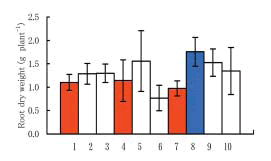Drought tolerance characteristics of Brazilian soybean cultivars
Description
[Objectives]
Soybean production in South America is highly productive but severely diminished if drought occurs during the reproductive growth stages of soybean crops. In order to illuminate the physiological and morphological characteristics associated with drought tolerance as measured by a yield index, scientists artificially measured drought stress during the reproductive growth stage of soybean cultivars from southern Brazil using rainout shelter treatment from 1999 to 2000.
[Results]
Researchers determined that yield ranking among cultivars in the rainout shelter (RS) plots was stable across the two-year period with a correlation coefficient for yield ranking significant at the 1% level (r=0.78). Although the irrigated plot showed the yield rankings in a different order, there was a significant correlation between the rankings for two seasons, suggesting that drought tolerance should be detectable using rainout treatment.
On the basis the RS plot yield figures, cultivar BRS 183 displayed high drought tolerance, while BR-16, Embrapa 59, and BRS 134 showed low drought tolerance (Table 1). The results of growth analysis (Table 2) in the RS plots during the rainout treatment period illustrated that the BRS 183 had a high relative growth rate (RGR), and thus, a high drought tolerance. BR-16, Embrapa 59, and BRS 134 displayed low RGRs and low drought tolerance. RGR differences reflected a difference in net assimilation rate (NAR), but the leaf area ratio (LAR) did not differ among cultivars. BRS 183 had large root dry weight during the drought period compared with the low drought tolerance cultivars, namely BR-16, Embrapa 59, and BRS 134 (Fig. 1).
Based on these results, it was concluded that relative growth rate during drought conditions for a one-month period following flowering can serve as a good index for analyzing how drought tolerance differs among cultivars. However, if drought occurs during other periods, drought response may not necessarily be the same as reported in this study.
Figure, table
-
Table 1. Seed yield of ten Brazilian soybean cultivars under drought conditions using rainout shelters.
After first flowering soybeans received no rains for one month under rain-out shelters. Cultivars with high drought tolerance are represented in blue and those with low tolerance in red. -
Table 2. Growth parameters of soybean cultivars in rainout-treated (RS) plots during the drought stress period (1999/2000).
After first flowering soybeans received no rains for one month under rain-out shelters. RGR=NAR × LAR. Cultivars with high drought tolerance are represented in blue and those with low tolerance in red. -
Fig. 1. Root dry weight of soybean plants 20 days after first flowering (2000/2001).
Means ± SD of 3 replicates. Cultivars with high drought tolerance are represented in blue and those with low tolerance in red.
- Affiliation
-
Japan International Research Center for Agricultural Sciences Crop Production and Environment Division
- Classification
-
Technical A
- Term of research
-
FY2002 (FY1999-2002)
- Responsible researcher
-
OYA Tetsuji ( Crop Production and Environment Division )
Nepomuceno Alexandre ( EMBRAPA Soybean )
NEUMAIER Norman ( EMBRAPA Soybean )
FARIAS José Renato Bouças ( EMBRAPA Soybean )
- ほか
- Publication, etc.
-
Oya, T., Nepomuceno, A.L., Neumaier, N., Farias, J.R.B., Tobita, S. and Ito, O. (2004): The drought tolerance characteristics of the Brazilian soybean cultivars. – Evaluation and characterization of drought tolerance among Brazilian cultivars in the field –. Plant Production Science, 7 (in press).
- Japanese PDF
-
2002_12_A3_ja.pdf757.78 KB
- English PDF
-
2002_12_A4_en.pdf46.04 KB



